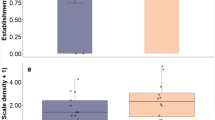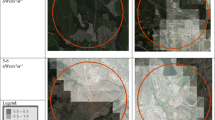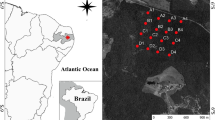Abstract
The frosted elfin (Callophrys irus [Godart]; Lepidoptera: Lycaenidae), is an imperiled species endemic to fire-maintained habitats in eastern North America. Callophrys irus spends the majority of the year as pupae that may be vulnerable to fires that occur during this life stage. One way C. irus survives fire is to burrow and pupate under the soil, but this behavior is variable between individuals. We ran an ex-situ test on the impact of two abiotic factors on the pupation depth of C.irus (n=60): ambient temperature and soil moisture. We used two incubators at 18℃ and 30℃ in addition to two moisture conditions of 5% and 15%. The null model outperformed other models, suggesting the effects of tested soil moisture and temperature levels on depth were negligible. The number of caterpillars that burrowed was similar to previous work as nine caterpillars burrowed fully beneath the soil surface. Therefore, if in-situ burrowing rates reflect our findings high mortality rates can be expected from fire. Only two caterpillars out of 60 (~ 3%) burrowed at a level deep enough to survive the expected lethal temperatures of a typical prescribed fire in north Florida.
Implications for insect conservation
Our results support previous recommendations on the importance of refugia and population/habitat-specific rotational burn schedules to ensure the long-term persistence of the species. These data, along with previously published evidence, suggest that caterpillars in-situ may be unlikely to pupate at depths deep enough to protect themselves against fire. Thus, land managers protecting small, isolated populations should consider artificial interventions when planning to burn.



Similar content being viewed by others
Data availability
Data may be available upon request.
References
Anderson RC, Fralish JS, Baskin JM (eds) (1999) Savannas, barrens, and rock outcrop plant communities of North America. Cambridge University Press, Cambridge, UK; New York, NY, USA
Arnold TW (2010) Uninformative parameters and model selection using Akaike’s information criterion. J Wildl Manag 74:1175–1178. https://doi.org/10.1111/j.1937-2817.2010.tb01236.x
Chapin S, Matson P, Vitousek P (2011) Principles of terrestrial ecosystem ecology, 2nd edn. Springer New York, New York
Chapman RF (1998) The insects: structure and function. Cambridge University Press
Chitwood MC, Lashley MA, Sherrill BL, Sorenson C, Deperno CS, Moorman CE (2017) Macroarthropod response to time-since-fire in the longleaf pine ecosystem. For Ecol Manag 391:390–395. https://doi.org/10.1016/j.foreco.2017.02.038
Chown SL, Nicolson SW (2004) Insect physiological ecology: mechanisms and patterns. Oxford University Press, Oxford, New York
R Core Team (2022) R: A language and environment for statistical computing
Dyson DS, Loewenstein EF, Jack SB, Brockway DG (2012) Influence of light and moisture on longleaf pine seedling growth in selection silviculture. In: Butnor, John R, ed 2012 Proceedings of the 16th biennial southern silvicultural research conference e-Gen Tech Rep SRS-156 Asheville, NC: US Department of Agriculture Forest Service, Southern Research Station 109–116 156:109–116
Eger JE, Sterling WL, Hartstack AW (1983) Winter survival of Heliothis virescens and Heliothis zea (Lepidoptera: Noctuidae) in College Station. Tex Environ Entomol 12:970–975. https://doi.org/10.1093/ee/12.3.970
Eskafi FM, Fernandez A (1990) Larval–pupal mortality of Mediterranean fruit fly (Diptera: Tephritidae) from interaction of soil, moisture, and temperature. Environ Entomol 19:1666–1670. https://doi.org/10.1093/ee/19.6.1666
Florida State University (2020) 1991–2020 temperature normals. Florida Climate Center
Frye JA, Tangren S (2013) Dual host plant use by Callophrys irus (Godart) (Lycaenidae) larvae at a single site on the Maryland coastal plain. News of the Lepidopterists Society 55:156–157
Grigore MT, Tramer EJ (1996) The short-term effect of fire on Lupinus perennis (L). Nat Areas J 16:41–48
Hanula JL, Wade DD (2003) Influence of long-term dormant-season burning and fire exclusion on ground-dwelling arthropod populations in longleaf pine flatwoods ecosystems. For Ecol Manag 175:163–184
Huey RB, Kingsolver JG (1989) Evolution of thermal sensitivity of ectotherm performance. Trends Ecol Evol 4:131–135. https://doi.org/10.1016/0169-5347(89)90211-5
Jue DK, Merwin AC, Jue SS, McElveen D, Inouye BD (2022) Effects of frequency and season of fire on a metapopulation of an imperiled butterfly in a longleaf pine forest. Conserv Sci Pract 4:e12739. https://doi.org/10.1111/csp2.12739
Karban R, Grof-Tisza P, Mcmunn M, Kharouba H, Huntzinger M (2015) Caterpillars escape predation in habitat and thermal refuges: Habitat and thermal refuges for caterpillars. Ecol Entomol 40:725–731. https://doi.org/10.1111/een.12243
Knight TM, Holt RD (2005) Fire generates spatial gradients in herbivory: an example from a Florida sandhill ecosystem. Ecology 86:587–593. https://doi.org/10.1890/04-1069
Mensua JL (1967) Some factors affecting pupation height of Drosophila. Drosophila Inform Service 42:76
Meyer RT, Pokswinski SM, Ney J, McElveen D (2023) Pupae survival following fire in the frosted elfin (Callophrys irus). Agric For Entomol 1–8. https://doi.org/10.1111/afe.12555
Moranz RA, Fuhlendorf SD, Engle DM (2014) Making sense of a prairie butterfly paradox: the effects of grazing, time since fire, and sampling period on regal fritillary abundance. Biol Conserv 173:32–41. https://doi.org/10.1016/j.biocon.2014.03.003
Motzkin G, Patterson WA, Foster DR (1999) A historical perspective on pitch pine-scrub oak communities in the Connecticut Valley of Massachusetts. Ecosystems 2:255–273
Pfitsch WA, Williams EH (2009) Habitat restoration for lupine and specialist butterflies. Restor Ecol 17:226–233. https://doi.org/10.1111/j.1526-100X.2008.00370.x
Pielström S, Roces F (2014) Soil moisture and excavation behaviour in the chaco leaf-cutting ant (Atta vollenweideri): digging performance and prevention of water onflow into the nest. PLoS ONE 9:e95658. https://doi.org/10.1371/journal.pone.0095658
Qi X-L, Wang X-H, Xu H-F, Kang L (2007) Influence of soil moisture on egg cold hardiness in the migratory locust Locusta migratoria (Orthoptera: Acridiidae). Physiol Entomol 32:219–224. https://doi.org/10.1111/j.1365-3032.2007.00564.x
Riedl CA, Riedl LM, Mackay TFC, Sokolowski MB (2007) Genetic and behavioral analysis of natural variation in Drosophila melanogaster Pupation position. Fly 1:23–32
Robertson KM, Platt WJ, Faires CE (2019) Patchy fires promote regeneration of longleaf pine (Pinus palustris Mill.) In Pine Savannas. Forests 10:367. https://doi.org/10.3390/f10050367
Robichaud P, Waldrop T (2007) A comparison of surface runoff and sediment yields from low-and high-severity site preparation burns. JAWRA J Am Water Resour Association 30:27–34. https://doi.org/10.1111/j.1752-1688.1994.tb03270.x
Schweitzer DF, Minno MC, Wagner DL (2011) Rare, declining, and poorly known butterflies and moths (Lepidoptera) of forests and woodlands in the eastern United States. Forest Health Technology Enterprise Team, Morgantown, WV
Selfridge JA, Bachran K, McElveen D, Robbins RK, Ransom T (2019) Pupation sites and conservation of frosted elfins (Lycaenidae) in Maryland, USA. lepi 73:87–92. https://doi.org/10.18473/lepi.73i2.a3
Sokolowski MB, Hansell RIC (1983) Elucidating the behavioral phenotype of Drosophila melanogaster larvae: correlations between larval foraging strategies and pupation height. Behav Genet 13:267–280
Sprague J (2013) Costs and benefits of an extended phenotype: Chambers made by Manduca sexta larvae. Master’s thesis, University of Montana
SSURGO Soil survey staff (2022) Natural Resources Conservation Service, United States Department of Agriculture. Web Soil Survey. Available online at https://websoilsurvey.nrcs.usda.gov/
Swengel A (1996) Observations of Incisalia irus (Lepidoptera: Lycaenidae in Central Wisconsin 1988-95. The Great Lakes Entomologist 29:47–62
Thom MD (2013) The ecology and conservation of Callophrys irus Godart: the role of fire and microhabitat. Dissertation, University of Florida
Thom MD, Daniels JC (2017) Patterns of microhabitat and larval host-plant use by an imperiled butterfly in northern Florida. J Insect Conserv 21:39–52. https://doi.org/10.1007/s10841-016-9950-2
Thom MD, Daniels JC, Kobziar LN, Colburn JR (2015) Can butterflies evade fire? Pupa Location and Heat Tolerance in Fire Prone Habitats of Florida. PLoS ONE 10:e0126755. https://doi.org/10.1371/journal.pone.0126755
USFWS (2018) Species Status Assessment Report for the Frosted Elfin (Callophrys irus). U.S. Fish and Wildlife Service, Cortland, New York
Varatharajan R, Daniel AM (1984) Studies on soil pupation in some phytophagous thrips. J Soil Biology Ecol 4:116–123
Wagner DL, Nelson MW, Schweitzer DF (2003) Shrubland Lepidoptera of southern New England and southeastern New York: ecology, conservation, and management. For Ecol Manag 185:95–112. https://doi.org/10.1016/S0378-1127(03)00249-4
Weber DA, Tanner EP, Terhune TM, Varner M, Martin JA (2022) Northern Bobwhite and Fire: a review and synthesis. NQSP 9. https://doi.org/10.7290/nqsp09V0ju
Wen Y, Jin X, Zhu C et al (2016) Effect of substrate type and moisture on pupation and emergence of Heortia vitessoides (Lepidoptera: Crambidae): choice and no-choice studies. J Insect Behav 29:473–489. https://doi.org/10.1007/s10905-016-9572-2
White CR, Harley GL (2016) Historical fire in longleaf pine (Pinus palustris) forests of south Mississippi and its relation to land use and climate. Ecosphere 7:e01458. https://doi.org/10.1002/ecs2.1458
Zheng X-L, Wang P, Lei C-L, Lu W, Xian Z-H, Wang X-P (2013) Effect of soil moisture on overwintering pupae in Spodoptera exigua (Lepidoptera: Noctuidae). Appl Entomol Zool 48:365–371. https://doi.org/10.1007/s13355-013-0196-0
Acknowledgements
We would like to thank Jessica Valdez and Apalachicola National Forest staff for allowing us to conduct work within the forest. Their overall support of the project has made this possible. We would also like to thank Dave McElveen and Jim Cox (Tall Timbers Research Station) for their edits and comments on the early manuscript and support of the project.
Funding
This project was made possible through funding from the Fish & Wildlife Foundation of Florida’s Conserve Wildlife Tag (CWT 21 − 13) and the U.S. Fish and Wildlife Service’s At-risk Species Program through the Wildlife Management Institute (SA 2020-04).
Author information
Authors and Affiliations
Contributions
Rob Meyer fulfilled the supervision role, funding acquisition, material preparation, and preformed the formal analysis and investigation. The conceptualizations and the original draft were written by Emma Jonas and Rob Meyer. All authors contributed to the methodology, the review and editing of each draft, and read and approved the final manuscript. Figure 1 was drawn by Emma Jonas using Inkscape 1.2.2.
Corresponding author
Ethics declarations
Competing interests
The authors declare no competing interests.
Ethical approval
Not applicable.
Additional information
Publisher’s Note
Springer Nature remains neutral with regard to jurisdictional claims in published maps and institutional affiliations.
Rights and permissions
Springer Nature or its licensor (e.g. a society or other partner) holds exclusive rights to this article under a publishing agreement with the author(s) or other rightsholder(s); author self-archiving of the accepted manuscript version of this article is solely governed by the terms of such publishing agreement and applicable law.
About this article
Cite this article
Jonas, E.N., Ball, N.T. & Meyer, R.T. The effect of soil moisture and ambient temperature on pupation depth for the imperiled Callophrys irus. J Insect Conserv 27, 805–811 (2023). https://doi.org/10.1007/s10841-023-00500-z
Received:
Accepted:
Published:
Issue Date:
DOI: https://doi.org/10.1007/s10841-023-00500-z




